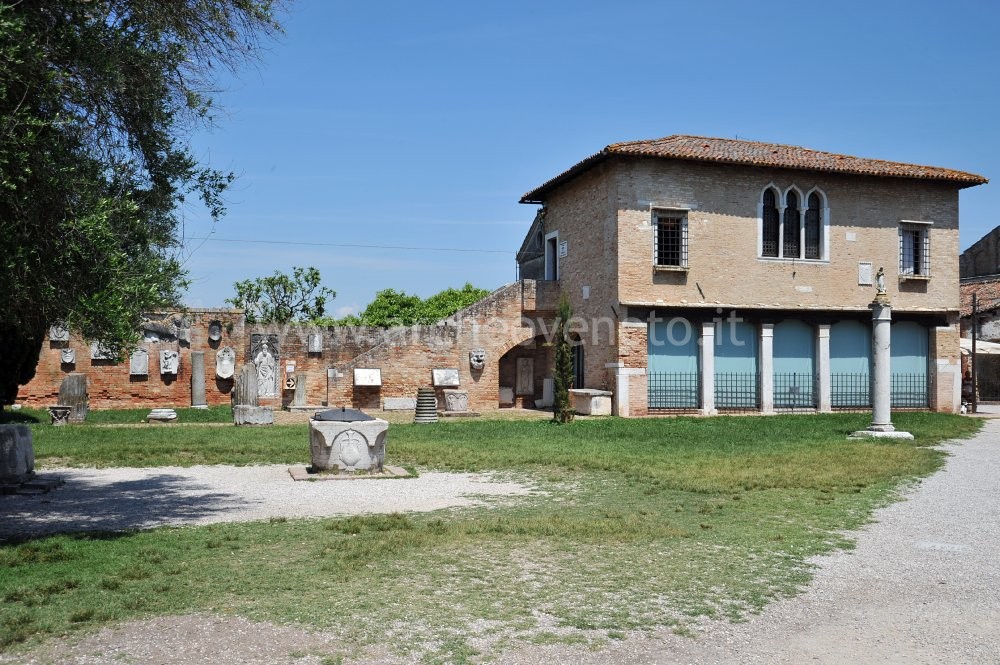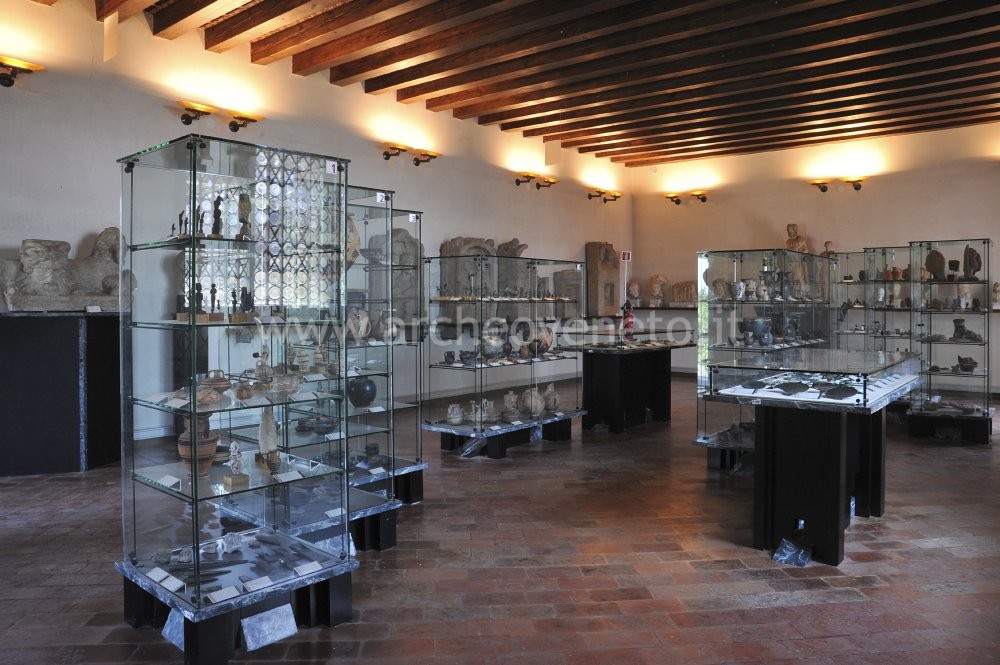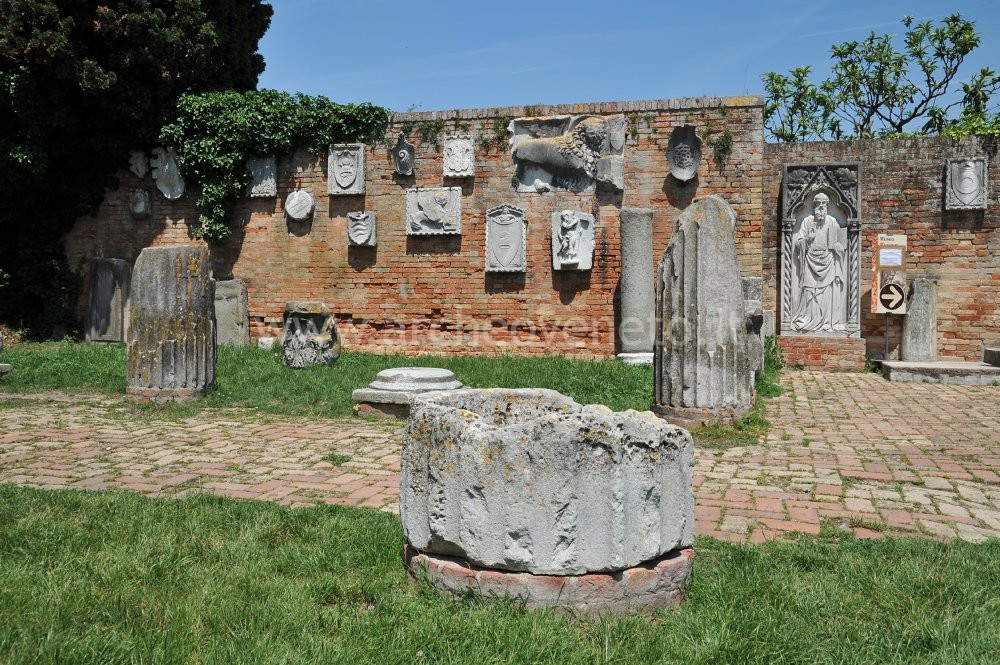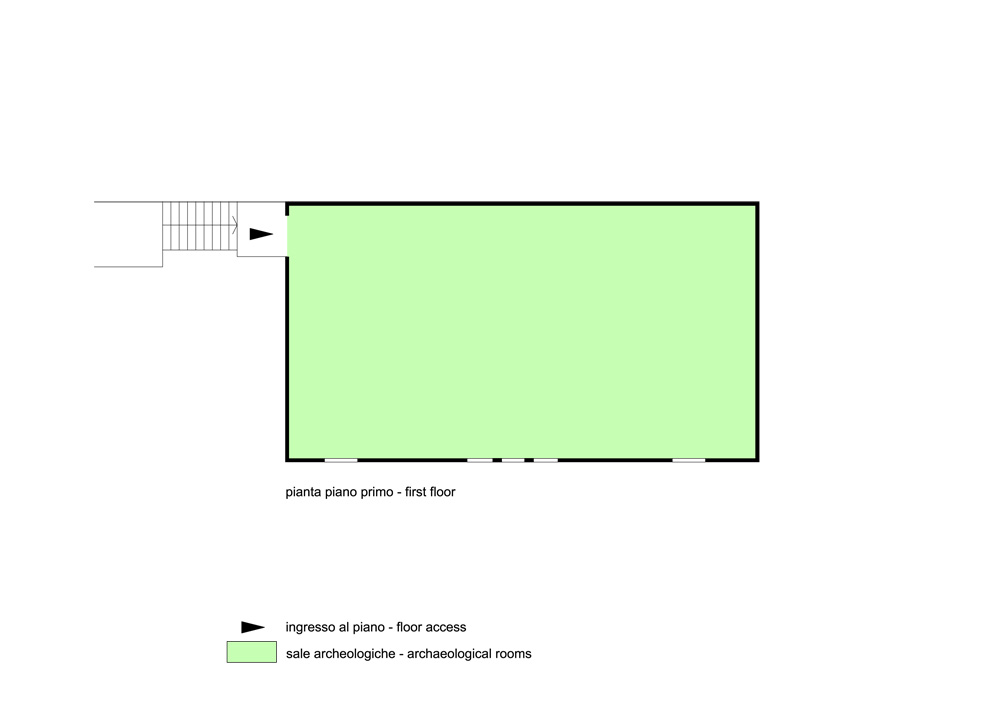|
|
File
Provincial Museum of Torcello, Archaeological Section – Venezia
|
Piazza Torcello – Torcello – 30100 Venezia (VE)
– Fax 041 2501773 (Settore Cultura – Provincia di Venezia) |
  |
|
Summary

The Provincial Museum of Torcello is organized into two parts: the archaeological section and the medieval-modern one, which are located in two historical buildings giving onto the main square of Torcello, a suggestive island of the Venetian lagoon. The archaeological section is located on the first floor of the Archive Palace, dating back to the 11th-12th cent. It consists of a single room, which displays a rich collection of pots, bronze objects, sculptures and other archaeological finds, the origin of which is often unknown, since they mostly come from private collections; yet they are very likely to stem from the local context, either the lagoon islands or the coastal area controlled by Altinum.
Collection history
In 1870 Luigi Torelli, who at the time was the prefect of Venice, purchased the Council Palace of Torcello, in order to collect all the ancient finds discovered in the Venetian Lagoon. Two years later, the Palace was donated to the Province of Venice, which established the Provincial Museum, entrusting its management to Nicolò Battaglini. In 1887 he was succeeded by Cesare Augusto Levi, who decided to purchase and refurbish the nearby Archive Palace to found the new "Estuary museum", which would contain all the archaeological collections. In 1974 the medieval and modern section was opened in the previously refurbished Council Palace. Thereafter also the Archive Palace was renovated and the archaeological section was re-organized in 1990. Beside the items found in Torcello, the other islands of the Lagoon and the close hinterland (area controlled by the municipality of Altinum), over time the exhibition has also included objects of unknown origin, coming from private collections mainly belonging to Venetian families.
|

 The museum is made up of one room only, located on the first floor of the Archive Palace, which can be considered a treasure containing the very precious traces of the Greek, Etruscan and Roman artistic traditions. The museum is made up of one room only, located on the first floor of the Archive Palace, which can be considered a treasure containing the very precious traces of the Greek, Etruscan and Roman artistic traditions.
The items displayed are particularly significant, on the one hand because the majority of the artefacts of the collection are almost undamaged (which is particularly astonishing as far as ceramic pots are concerned) and on the other hand on because they come almost exclusively (even though there are many uncertainties) from the islands of the lagoon or the coastal area (controlled by Altinum). For example, on the third shelf of the first display case there are four important Mycenaean pots (1400-1200 B.C.) almost certainly found in the lagoon and two even more ancient Cypriot pots (1700-1600 B.C.) which bear witness to the maritime relations between the eastern Mediterranean and the upper Adriatic sea. The same display case contains also two shelves with Egyptian statuettes in bronze and clay, a shelf with pottery of different origins (Ionic, Ionic-Etruscan; Egyptian and eastern-Greek) dating back to the second half of the 6th cent. and the 5th cent. B.C. and one last shelf mainly showing prehistoric objects, such as weapons and bronze tools: two axes of worked stone, two worked deer antlers and three flint cores.
The second display case contains other pots of extraordinary historical and artistic importance. On the top shelf there is only a wonderful Meso-Corinthian column krater (590-575 B.C.). On the second shelf it is possible to see three aryballoi and three Italo-Corinthian alabastra (late 7th cent. – first half of the 6th cent. B.C.) a proto-Corinthian aryballos (650 – 640 B.C.) and a Corynthian lekanis (4th cent. B.C.); the following two shelves contain black varnished pots in Attic ceramic of the 5th and 4th cent. B.C. (a lekanis, five lamps and four kylikes).
The following display case contains only ceramic objects manufactured in Attica. On the first shelf there are vases of different kind produced with the black figure technique, which date back to the 5th century; on the shelf below there are vases of different shapes with red figures (late 5th cent.- first half of the 4th cent.). The bottom shelves contain black-varnished vases manufactured in Attica (late 5th-4th cent. B.C.).
The objects contained in the fourth display case are very different: on the top shelf there is a rich exhibition of bronze statuettes, dating back to a time span between the 7th and the 3rd cent. B.C. This rich group of items includes some Etruscan statuettes (6th-5th cent. B.C.), a remarkable amount of statuettes produced in Veneto that represent animals, believers, warriors, riding warriors, as well as some deities (Mars and Heracles). On the central shelf there are Etruscan vases of different shapes and kinds (6th-3rd cent. B.C.), whereas the bottom shelf contains numerous examples of Adriatic pottery, partially of Peucetian, Daunian and Messapian origin (second half of the 6th-3rd cent. B.C.) and partially coming from the upper Adriatic region (two oinochoai -wine jars- with red figures of the 4th-3rd cent. B.C. and two pyxes with string decoration of the year 300 B.C. approximately).
The fifth display case contains ornamental objects of different kind, which are very likely to come from the coastal area controlled by Altinum. There is a rich exhibition of bronze artefacts: a mirror with the representation of the Dioskouroi (3rd cent. B.C.) and three mirrors with the representation of Lasa, Etruscan female deities, (late 4th cent. – 3rd cent. B.C.), armillae (bracelets), fragments of pins, a razor, fibulae (brooches), “leech” fibulae and fibulae of other shapes, pieces of rings and necklaces dating back to a time span between the 9th century and the Romanization period. Next to the bronze items, there are also objects in glass and amber. The following display case contains pottery of different kinds of Apulian and Campanian origin, in the Gnathia style, which date back to the 4th-3rd cent. B.C.; the bottom shelf displays black-varnished ceramic objects of the 4th-2nd cent. B.C.
The objects contained in the seventh display case are rather heterogeneous. The top shelf displays five earthen heads (a female votive head of the 5th-4th cent. B.C., two veiled votive female heads of the 3rd-2nd cent. and 3rd cent. B.C. respectively and two veiled male heads of the 2nd cent. B.C.); the second shelf contains bronze and earthen statuettes representing deities that date back to the Roman age; on the third shelf there are some fragments of earthen depicted plates (1st cent. B.C. – 1st cent. A.D.) and an earthen foot (2nd- 1st cent. B.C.); the fourth shelf shows some Roman phallic amulets in bronze and some earthen objects dating back to the 2nd-1st cent. B.C.: a womb-shaped ex-voto, two fragments of bovid statuettes and a tragic mask; on the fifth shelf there are three earthen antefixes (late 1st cent. B.C. – 1st cent A.D.) and a lion protome dripstone (3rd-2nd cent. B.C.).
The eighth display case shows different kinds of ceramic pots (utilitarian, sigillata and thin walled pottery) and of lamps of the Roman age; the bottom shelf shows lamps dating back to Late Antiquity and the Early Middle Ages, as well as five cruets and a statuette like the one of San Menas (5th-6th cent. A.D.).
Also the ninth display case contain heterogeneous objects of the Roman age, which include bronze cups and vases, bronze statuettes and votive objects, a marble female head, a marble portrait of the emperor Balbinus (coming probably from Torcello), ivory and bone artefacts, keys, bells and weights in metal, earthen spindle whorls, two fistulae (water pipes) in lead and an antefix.
The tenth and last display case contains different bronze objects dating back to the roman age: different tools, rings, fibulae, tweezers, putty knives, a mirror and other items.
Along the walls of the room, there are important sculptural remains, some of which certainly come from the area of Altinum. On the left wall, there are a sphinx, originally part of a funerary stele (first half of the 1st cent. A.D.), a lion from a funerary monument; a marble portrait of a woman (1st cent. A.D.), six funerary steles, some of which belong to the aedicule-shaped type with the portraits of the departed placed on two levels (1st-2nd cent. A.D.). On the wall at the bottom of the room there are wonderful examples of sculptures and relieves of the Greek and Roman ages. They include a female head from a Greek funerary stele (5th cent. B.C.), a Greek votive relief (late 4th-3rd cent. B.C.), a veiled male head probably representing Kronos (late 4th-3rd cent. B.C.), a funerary or votive relief dating back to the late Hellenistic Age, a statue of Asclepius with the head of Serapis (1st- 2nd cent. A.D.), a herma of Hermes Propylaios (early 2nd cent. A.D.) and other sculptures of the Roman age. On the right wall it is possible to see four portraits of the roman age, as well as, inside the two display cases, some fragments of painted plaster (1st cent. A.D.) and a prestigious collection of Roman gems and cameos probably coming from the area of Altinum.
Finally on one side of the entrance door, there is a plate with a relief representing Attis that dates back to the late Imperial age.
|

 Outside, between the building of the Archaeological Section and the one hosting the Medieval and Modern Section, it is possible to see some architectural elements, as well as some inscriptions mainly coming from the area of Altinum. Other stone artefacts (urns, altars, funerary monuments and stones) are displayed in the loggia on the ground floor of the Archive Palace. Outside, between the building of the Archaeological Section and the one hosting the Medieval and Modern Section, it is possible to see some architectural elements, as well as some inscriptions mainly coming from the area of Altinum. Other stone artefacts (urns, altars, funerary monuments and stones) are displayed in the loggia on the ground floor of the Archive Palace.
|

Admission: Negli orari di apertura
Ticket: Si
Price: Full fare: 3 €; reduced fare: 1.5 € for groups of more than 10 people; free admission for people aged more than 65 and for pupils and students from schools of any kind and level (if accompanied by a teacher)
NOTE: the ticket includes the visit to both sections of the museum.
 School access School access
Opening Days
| Tipology |
When |
Specs |
| Summer |
Tuesday |
10.30-17.30 |
| Summer |
Wednesday |
10.30-17.30 |
| Summer |
Thursday |
10.30-17.30 |
| Summer |
Friday |
10.30-17.30 |
| Summer |
Saturday |
10.30-17.30 |
| Summer |
Sunday |
10.30-17.30 |
| Winter |
Tuesday |
10.00-17.00 |
| Winter |
Wednesday |
10.00-17.00 |
| Winter |
Thursday |
10.00-17.00 |
| Winter |
Friday |
10.00-17.00 |
| Winter |
Saturday |
10.00-17.00 |
| Winter |
Sunday |
10.00-17.00 |
Summer timetable (1/03 – 31/10); Winter timetable (1/11 – 28/02)
Recommended tour time (minutes): 30
 Toilet Toilet
Outside the museum; fee: 1.5 €
 Rest points Rest points
In the room there is a comfortable bench with padded seat.
 Information boards Information boards
One introductory panel in Italian and English
 Mobile cards Mobile cards
Italian and English
 Captions under exhibits Captions under exhibits
Italian and English
 Multilingual ads: Inglese Multilingual ads: Inglese
Fixed panels, information sheets and captions about the works.
| Callegari A. 1930, Il Museo Provinciale di Torcello, Venezia. |
| Polacco R. 1976, Sculture paleocristiane e altomedievali di Torcello, Treviso. |
| Favaretto I. 1981, Ceramica greca italiota ed etrusca del Museo Provinciale di Torcello, Roma. |
| Tombolani M. 1981, Bronzi figurati etruschi, italici, paleoveneti e romani del Museo Provinciale di Torcello, Roma. |
| Ghedini F., Rosada G. 1982, Sculture greche e romane del Museo Provinciale di Torcello, Roma. |
| Il Museo di Torcello: bronzi, ceramiche, marmi di età antica. Catalogo 1993, a cura di Fogolari G. , Venezia. |
| Il Museo di Torcello. Guida breve alle due sezioni 1994, Venezia. |
| Musei e raccolte archeologiche del Veneto 2004, a cura di Di Mauro A., Dosson di Casier, pp. 97-99. |
| Bonetto J. 2009, Veneto (Archeologia delle Regioni d’Italia), Roma, pp. 432-434. |
| L’antica Torcello s.d., in Quaderni didattici del Museo Provinciale di Torcello 1 , a cura di Culos E. . |
|

